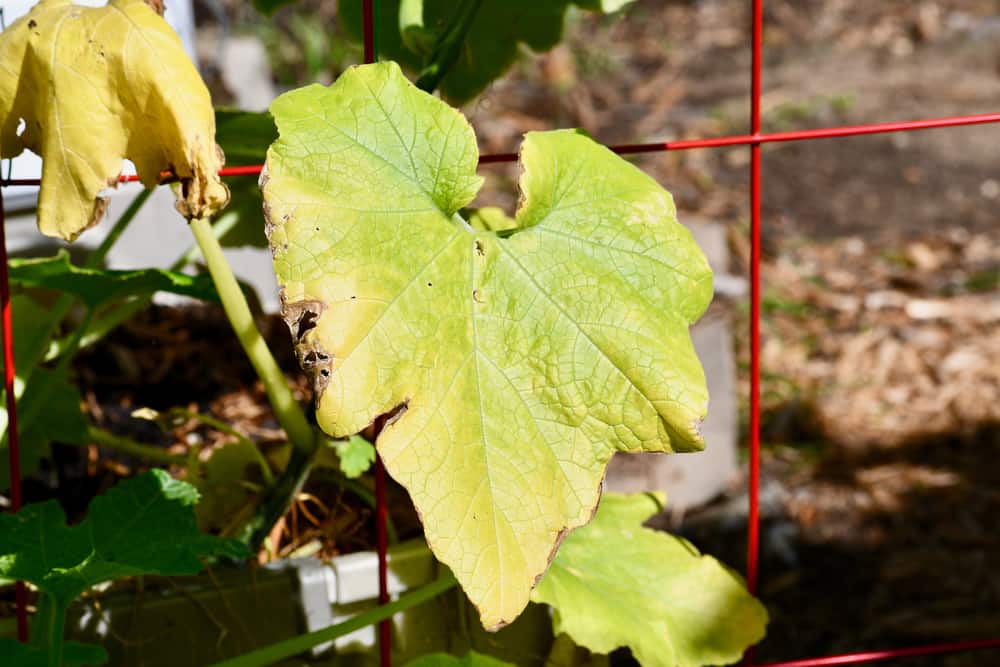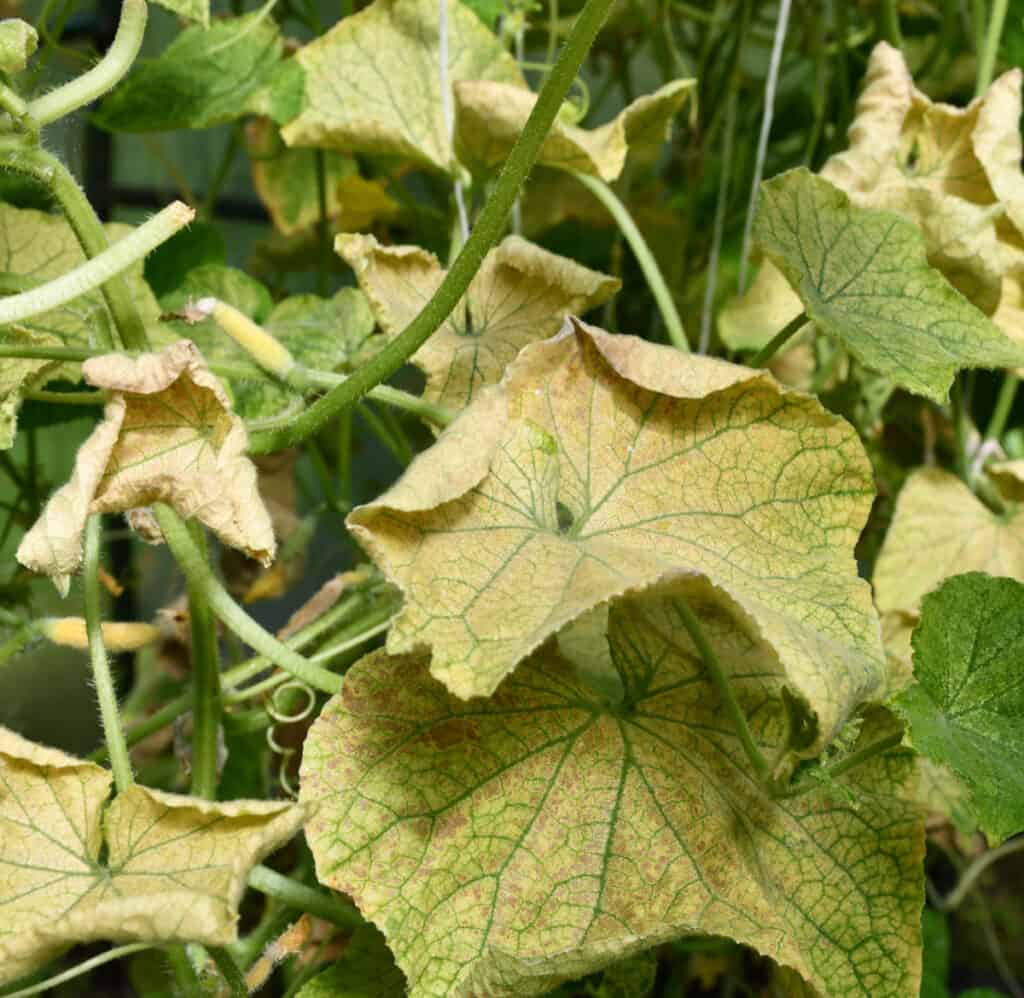To treat yellowing cucumber leaves, identify the cause and adjust watering, fertilizing, or sunlight exposure accordingly. Yellowing leaves can be caused by overwatering, nutrient deficiencies, or fungal diseases.
Analyze the soil moisture level and adjust watering frequency to prevent waterlogged roots. Inspect the leaves for signs of nutrient deficiencies and provide appropriate fertilization. Ensure the plants receive enough sunlight by providing 6-8 hours of direct sunlight daily. Monitor the leaves for any signs of fungal infections and treat with appropriate fungicides if necessary.
Regularly remove any yellowing or diseased leaves to prevent further spread.

Credit: wildyards.com
Understanding Yellowing Cucumber Leaves
Yellowing cucumber leaves can be a cause for concern among gardeners. Understanding why this happens is crucial for effective treatment. One common cause of yellowing cucumber leaves is stress from environmental factors such as excessive heat or cold. Another factor to consider is nutrient deficiency, particularly lack of nitrogen or magnesium.
Pests and diseases can also lead to yellowing leaves, with common culprits being aphids, cucumber beetles, or fungal infections. Overwatering or poor drainage can contribute to leaf discoloration as well. To treat yellowing cucumber leaves, it is important to address the underlying cause.
Adjusting watering practices, providing proper nutrition, and implementing pest control measures can help restore the health of the plant. Regular monitoring and timely intervention are key to maintaining green, vibrant cucumber leaves.
Identifying And Treating Nutrient Deficiencies
Cucumber leaves turning yellow can be a sign of nutrient deficiencies in your plants. To identify these deficiencies, look for specific symptoms such as yellowing leaves with green veins (indicating nitrogen deficiency), yellowing leaves with brown edges (indicating potassium deficiency), or leaves with interveinal chlorosis (indicating magnesium deficiency).
Once you’ve identified the deficiency, you can treat it by addressing the specific nutrient problem. For nitrogen deficiency, consider applying organic fertilizers that are higher in nitrogen content. For potassium deficiency, use organic fertilizers or foliar sprays with potassium-rich ingredients.
And for magnesium deficiency, try applying Epsom salt or a magnesium-rich foliar spray. These methods can help restore the nutrient balance in your cucumber plants and keep their leaves healthy and green. Remember to follow the instructions on the fertilizer or spray packaging for best results.
How to Treat Yellowing Cucumber Leaves: Step by Step Guide
Managing Common Pests And Diseases
Managing common pests and diseases is essential for treating yellowing cucumber leaves. One way to address this issue is by recognizing signs of pest infestation in cucumber plants. Aphids, spider mites, and cucumber beetles are common culprits that need to be treated.
Additionally, it is crucial to prevent and control diseases such as powdery mildew and bacterial wilt. Taking proactive measures like regular inspection, removing affected leaves, and using organic pest control methods can help keep the plants healthy. By being vigilant and implementing these strategies, gardeners can effectively treat yellowing cucumber leaves and ensure a thriving crop.
Remember, early intervention is key to prevent further damage and maintain the overall health of the plants.
Implementing Proper Watering And Drainage Practices
Proper watering and drainage practices play a vital role in treating yellowing cucumber leaves. Consistent watering is essential for maintaining healthy cucumber plants. Overwatering should be avoided to prevent root rot, which can contribute to yellowing leaves. To ensure adequate drainage, it is necessary to improve the soil’s ability to absorb and release water efficiently.
Waterlogged soil can suffocate the roots and lead to various problems, including yellowing leaves. By implementing proper watering techniques and enhancing drainage, you can optimize the health of your cucumber plants.
Providing Optimal Growing Conditions
Cucumber leaves turning yellow can be treated by providing optimal growing conditions. Ensuring adequate sunlight and temperature is crucial for cucumber plants. Selecting the right location and soil for cultivation plays a vital role in their health. Protecting the plants from extreme weather conditions is also important for maintaining their well-being.
By following these guidelines, you can maximize the chances of your cucumber plants thriving and avoid the issue of yellowing leaves. Remember to monitor the growing conditions regularly and make adjustments as needed to keep your cucumber plants healthy and vibrant.
With the right care, you can enjoy a bountiful harvest of delicious cucumbers.
Pruning And Supporting Cucumber Plants
Pruning cucumber vines can offer significant benefits, such as promoting healthier plants. By removing yellowing leaves, you enable better air circulation, preventing diseases and enhancing overall plant vigor. This technique also helps direct energy to fruit production, improving yields. To do this, trim any foliage that looks discolored or damaged, ensuring you use clean pruning tools between cuts to prevent the spread of disease.
In addition to pruning, supporting your cucumber plants is equally important. Using trellises or stakes helps minimize contact with moist soil, reducing the risk of foliar diseases and pests. It also saves space in your garden and allows for easier harvesting.
So, give your cucumber plants some love by pruning and supporting them, and enjoy a healthy and abundant harvest.
Enhancing Pollination And Fruit Set
Cucumber plants with yellowing leaves can be rescued by enhancing pollination and fruit set. To ensure a successful pollination process, it is essential to attract pollinators to your garden. Bees, butterflies, and other insects can be enticed by planting flowers nearby and providing a water source.
Additionally, hand pollination techniques can be employed to increase fruit set. Gently transferring pollen from male to female flowers using a small brush or cotton swab helps ensure that each flower is adequately pollinated. By diversifying the phrases used in these gardening tips, readers can remain engaged and grasp the importance of pollination in maintaining healthy cucumber plants.
So, follow these practices to treat yellowing cucumber leaves and enjoy a bountiful harvest of fresh and vibrant cucumbers.
Harvesting And Preservation Tips
Harvesting cucumber fruits at the right time is crucial for optimal taste and texture. Look for firm, dark green cucumbers and twist them gently to detach from the vine. Avoid pulling or tugging, as it may damage the vine or fruit.
Once harvested, promptly store cucumbers in the refrigerator to retain their freshness. Wrap them in a damp paper towel or place them in a plastic bag to prevent moisture loss. Proper storage helps preserve their crispness for longer. To prevent post-harvest diseases and decay, inspect the cucumbers regularly and remove any spoiled ones immediately.
Additionally, avoid overcrowding the fridge, which can lead to accelerated decay. Follow these tips to ensure your cucumber harvest remains healthy and delicious.
Preventive Measures For Future Yellowing
When treating yellowing cucumber leaves, it is important to implement preventive measures for future yellowing. This can be done by maintaining good garden hygiene and sanitation practices. It is also recommended to rotate cucumber crops in order to prevent soil-borne diseases.
Regularly inspecting plants and taking proactive measures against any issues that arise can help in preventing yellowing. By following these guidelines, you can ensure that your cucumber plants stay healthy and free from yellowing.
Frequently Asked Questions On How To Treat Yellowing Cucumber Leaves
What Does It Mean If Your Cucumber Leaves Are Turning Yellow?
Yellowing of cucumber leaves indicates nutrient deficiency or overwatering. Check soil pH, watering frequency, and nutrient levels for proper care.
Should You Cut Yellow Leaves Off Cucumber Plants?
Yes, it is recommended to cut yellow leaves from cucumber plants.
What Does Epsom Salt Do For Cucumber Plants?
Epsom salt boosts the growth and productivity of cucumber plants due to its magnesium content.
What Do Overwatered Cucumbers Look Like?
Overwatered cucumbers can have yellowing leaves, wilting, and overly soft or mushy roots.
Conclusion
To ensure the health and productivity of your cucumber plants, it is essential to address the issue of yellowing leaves. By following the tips and strategies discussed in this blog post, such as regular watering, proper spacing, and identifying and treating pest infestations, you can mitigate and prevent yellowing cucumber leaves.
Remember to maintain a balanced nutrient supply and provide adequate sunlight to promote vigorous growth. A proactive approach, such as removing affected leaves and inspecting plants regularly, can help you catch problems early on and take corrective action. By implementing these strategies and giving your cucumbers the care they need, you can enjoy a bountiful harvest and healthy plants throughout the growing season.
Keep in mind that every garden is unique, and it may require some trial and error to find the best solution for your specific situation. Happy gardening!

